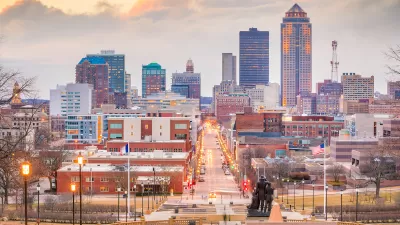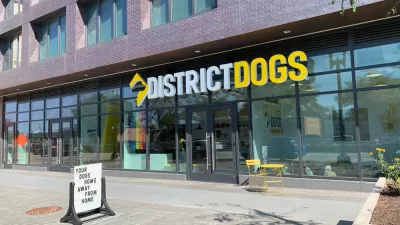In the wealthy community of Spring Valley, just inside the western boundaries of the District of Columbia, residents are opposing a proposed development by claiming the site—a parking lot—is a historic landmark.
Aaron Wiener begins his coverage of the parking lot as historic landmark by telling the story of its original development in 1942, as a pioneering suburban retail landmark. The site has changed hands, original developed as a Garfinckel's and some features of the neighborhood have also changed (the end of racial covenants, for instance), but developers are still interested in the site.
"Last fall, Miller sold the Spring Valley Shopping Center on Massachusetts Avenue NW, anchored by the Crate & Barrel that took over the old Garfinckel’s space, to the Washington Real Estate Investment Trust. WRIT, as it’s known, recently announced plans to erect a two-story building on a portion of the parking lot between Crate & Barrel and Capital One Bank, with ground-floor retail topped by offices or additional retail."
And here's the rub. Residents would rather keep the parking lot, and they're pulling the historic preservation card to make the case. The argument isn't that this particular parking lot has some unique design or environmental feature that makes it outstanding. Rather, "what some neighbors do claim is that because the parking lot was built at a time of car-focused retail development, it is an historic landmark," according to Wiener.
Weiner goes on to provide a lot more detail about the specific example of the Spring Valley case study, as well as the larger question about the nature of historic preservation it raises. For the record, the case for parking lots as a signature feature of American development history was made in detail by David Rotenstein on the National Council on Public History website in 2014.
FULL STORY: A Lot to Lose: Can a Parking Lot Be an Historic Landmark?

Planetizen Federal Action Tracker
A weekly monitor of how Trump’s orders and actions are impacting planners and planning in America.

Congressman Proposes Bill to Rename DC Metro “Trump Train”
The Make Autorail Great Again Act would withhold federal funding to the system until the Washington Metropolitan Area Transit Authority (WMATA), rebrands as the Washington Metropolitan Authority for Greater Access (WMAGA).

The Simple Legislative Tool Transforming Vacant Downtowns
In California, Michigan and Georgia, an easy win is bringing dollars — and delight — back to city centers.

The States Losing Rural Delivery Rooms at an Alarming Pace
In some states, as few as 9% of rural hospitals still deliver babies. As a result, rising pre-term births, no adequate pre-term care and "harrowing" close calls are a growing reality.

The Small South Asian Republic Going all in on EVs
Thanks to one simple policy change less than five years ago, 65% of new cars in this Himalayan country are now electric.

DC Backpedals on Bike Lane Protection, Swaps Barriers for Paint
Citing aesthetic concerns, the city is removing the concrete barriers and flexposts that once separated Arizona Avenue cyclists from motor vehicles.
Urban Design for Planners 1: Software Tools
This six-course series explores essential urban design concepts using open source software and equips planners with the tools they need to participate fully in the urban design process.
Planning for Universal Design
Learn the tools for implementing Universal Design in planning regulations.
Smith Gee Studio
City of Charlotte
City of Camden Redevelopment Agency
City of Astoria
Transportation Research & Education Center (TREC) at Portland State University
US High Speed Rail Association
City of Camden Redevelopment Agency
Municipality of Princeton (NJ)





























